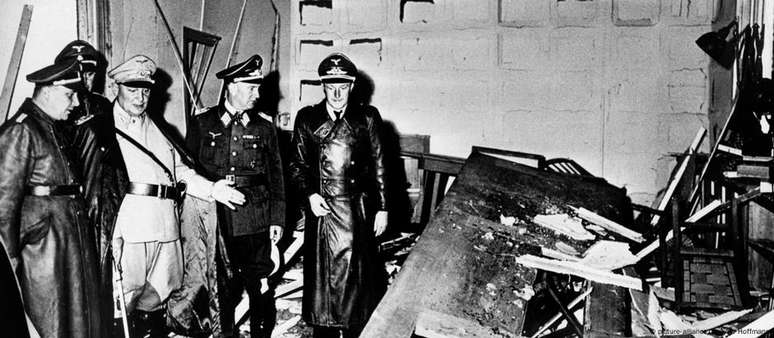On July 20, 1944, Colonel Stauffenberg planted a bomb in Hitler’s headquarters. The attempt to kill the dictator failed, and the conspirators were only given hero status long after the end of the war. On July 20, 1944, at 12:42 p.m., a bomb exploded in the assembly barracks of the Nazi Army headquarters in East Prussia. Placed by Count Claus Schenk von Stauffenberg, a colonel in the Wehrmacht, its purpose was to kill the dictator Adolf Hitler.
Once an ardent Nazi, now, after five years of World War II, with Germany visibly on the losing end, Stauffenberg saw no alternative: “Then there is nothing left to do but kill him,” he had told his closest confidants a few days earlier.
Stauffenberg was not only the perpetrator of the assassination, but also the main organizer of a large-scale coup attempt by conservative circles, which included high-ranking military personnel, many of them of noble origin, diplomats and administrative officials.
The officer left the room shortly before the bomb exploded and saw the explosion from outside. When he flew to Berlin shortly afterward, he believed Hitler was dead.
Operation Valkyrie began in the capital, originally a plan of the Wehrmacht (Nazi military) to suppress a possible uprising. The conspirators, scattered everywhere in key positions in the state apparatus, intended to transform the operation into a coup d’état.
Summary end of the coup attempt
But Hitler managed to escape with only minor injuries. The heavy oak table and the windows of the room, wide open in the summer heat, diverted the pressure of the explosion. Even so, a coup would not have been ruled out if those involved had carried out Operation Valkyrie without deviations.
But there were delays, setbacks and poor planning. In addition, under the enormous pressure of being discovered, some members became passive or even switched sides. By evening it was already clear that the coup attempt had failed. Hitler addressed the population by radio, invoking the “providence” that had saved him.
Stauffenberg and several other conspirators were arrested and shot the same day. Others were discovered later. In total, about 200 resistance members were executed.
For historian Wolfgang Benz, the main reason for the failure was that “none of the famous army commanders” of the time, such as General Erwin Rommel, directly joined the operation: “At least one of them would have had to take the initiative, then people would say: ‘Ah, Rommel also considers Hitler a criminal.'”
Nevertheless, July 20, 1944, became a powerful symbol of resistance against Hitler. Henning von Tresckow, Stauffenberg’s conspirator, had come to the conclusion a few days earlier that the decisive factor was not success, “but that the German resistance movement dared to make the decisive move, before the world and history, by putting its own life at risk.”
Questionable cult
The celebration of the assassination had its own history: until long after the war the perpetrators were considered traitors. Stauffenberg’s widow was initially denied a pension. Later the conspirators were given official heroic status: numerous streets, schools and barracks are named after them; on July 20, flags are raised in front of public buildings.
On the anniversary of the attack, swearing-in ceremonies are held for Bundeswehr recruits. For the German Democratic Army, the resistance members led by former Wehrmacht officer Stauffenberg are identifying figures.
But there have always been critical voices against this cult. Stauffenberg’s biographer, Thomas Karlauf, points out that the group only began to act in mid-1944, shortly after the Allied landings in Normandy. But around 1940, after rapid military victories over Poland and France, Stauffenberg still referred to the results with enthusiasm: “What a transformation, in such a short period of time!”
For him and other men in the military resistance, there was “a very, very long road to catharsis,” Benz says, adding, “The Holocaust did not interest them at all.” In the face of imminent military defeat, a coup was intended to “save what could be saved” for Germany.
Stauffenberg wasn’t the only one
According to historian Johannes Hürter, Stauffenberg was not a democrat and envisioned an authoritarian form of government for Germany if the attack were successful.
Benz is less severe: “In any case, Germany would have returned to being a state of law, but a democracy on our model, as established by the Basic Law.” [Constituição] German, was not the vision of the July 20 conspirators.”
Controversies aside, when talking about resistance to National Socialism, many Germans first think of this episode, of which Count Claus Schenk von Stauffenberg is the leader of the movement.
But there were other actions, such as the almost successful attempt by the craftsman Georg Elser, in 1939, to kill Hitler with a homemade bomb in the Bürgerbräukeller beer hall in Munich, where the dictator was speaking; or the distribution of leaflets by the anti-Nazi resistance group White Rose.
Subsequently, such actions were unfairly cast into the shadow of the “late, not to say belated, resistance of the conservative elites”, as Benz calls the attack of July 20, 1944.
It is certain that many other heroes and heroines opposed the regime’s terror: Jews, communists, clergy, artists, activists. And certainly also people who resisted silently, almost invisibly, and whose actions have now fallen into oblivion.
Source: Terra
Rose James is a Gossipify movie and series reviewer known for her in-depth analysis and unique perspective on the latest releases. With a background in film studies, she provides engaging and informative reviews, and keeps readers up to date with industry trends and emerging talents.







